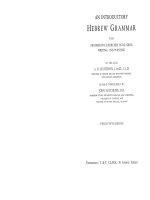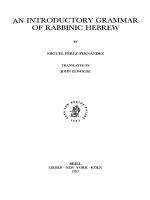There as an introductory subject
Bạn đang xem bản rút gọn của tài liệu. Xem và tải ngay bản đầy đủ của tài liệu tại đây (12.04 KB, 1 trang )
There as an introductory subject
In English the most common way of indicating existence is by using the structure there + to be. Though there is
an adverb of place the introductory there has no adverbial sense. It is merely used to introduce the sentence.
Consider the sentence ‘There are two men in the room’. This sentence may also be written as ‘Two men are in
the room’.
Normally the first form is preferred, though the subject is ‘two men’.
More examples are given below.
There is a bridge over the river.
There is a way out.
There is no such thing.
There is no denying the fact that she did it.
There is no knowing when he will return.
In the last two sentences we use a peculiar structure after there + be –– no + gerund which shows impossibility.
There is no denying the fact that she did it. = It is impossible to deny the fact that she did it.
There is no knowing when he will return. = It is impossible to know when he will return.
Notes
The sentence ‘There is no question of going back on it’ is not correct in standard English. But you can say,
‘Going back on it is out of question’.
Introductory there can also be used with some intransitive verbs.
There arose a dispute about the ownership of the property.
There grew a strange relationship between them.
Sometimes the introductory there is used with an intransitive verb + to be.
There seems to be some misunderstanding between them.
Stay on top of your writing! Download our grammar guide from www.englishgrammar.org to stay up-to-date.
Powered by TCPDF (www.tcpdf.org)









